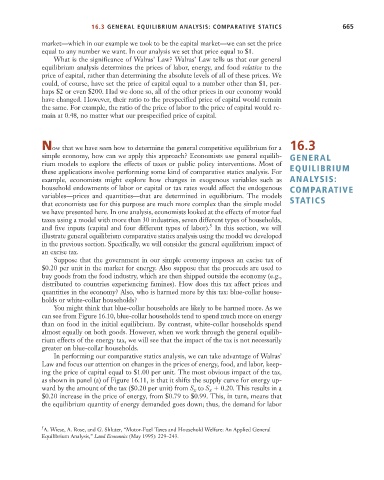Page 691 - Microeconomics, Fourth Edition
P. 691
c16GeneralEquilibriumTheory.qxd 8/16/10 9:13 PM Page 665
16.3 GENERAL EQUILIBRIUM ANALYSIS: COMPARATIVE STATICS 665
market—which in our example we took to be the capital market—we can set the price
equal to any number we want. In our analysis we set that price equal to $1.
What is the significance of Walras’ Law? Walras’ Law tells us that our general
equilibrium analysis determines the prices of labor, energy, and food relative to the
price of capital, rather than determining the absolute levels of all of these prices. We
could, of course, have set the price of capital equal to a number other than $1, per-
haps $2 or even $200. Had we done so, all of the other prices in our economy would
have changed. However, their ratio to the prespecified price of capital would remain
the same. For example, the ratio of the price of labor to the price of capital would re-
main at 0.48, no matter what our prespecified price of capital.
Now that we have seen how to determine the general competitive equilibrium for a 16.3
simple economy, how can we apply this approach? Economists use general equilib- GENERAL
rium models to explore the effects of taxes or public policy interventions. Most of
these applications involve performing some kind of comparative statics analysis. For EQUILIBRIUM
example, economists might explore how changes in exogenous variables such as ANALYSIS:
household endowments of labor or capital or tax rates would affect the endogenous COMPARATIVE
variables—prices and quantities—that are determined in equilibrium. The models
that economists use for this purpose are much more complex than the simple model STATICS
we have presented here. In one analysis, economists looked at the effects of motor fuel
taxes using a model with more than 30 industries, seven different types of households,
5
and five inputs (capital and four different types of labor). In this section, we will
illustrate general equilibrium comparative statics analysis using the model we developed
in the previous section. Specifically, we will consider the general equilibrium impact of
an excise tax.
Suppose that the government in our simple economy imposes an excise tax of
$0.20 per unit in the market for energy. Also suppose that the proceeds are used to
buy goods from the food industry, which are then shipped outside the economy (e.g.,
distributed to countries experiencing famines). How does this tax affect prices and
quantities in the economy? Also, who is harmed more by this tax: blue-collar house-
holds or white-collar households?
You might think that blue-collar households are likely to be harmed more. As we
can see from Figure 16.10, blue-collar households tend to spend much more on energy
than on food in the initial equilibrium. By contrast, white-collar households spend
almost equally on both goods. However, when we work through the general equilib-
rium effects of the energy tax, we will see that the impact of the tax is not necessarily
greater on blue-collar households.
In performing our comparative statics analysis, we can take advantage of Walras’
Law and focus our attention on changes in the prices of energy, food, and labor, keep-
ing the price of capital equal to $1.00 per unit. The most obvious impact of the tax,
as shown in panel (a) of Figure 16.11, is that it shifts the supply curve for energy up-
ward by the amount of the tax ($0.20 per unit) from S to S x 0.20. This results in a
x
$0.20 increase in the price of energy, from $0.79 to $0.99. This, in turn, means that
the equilibrium quantity of energy demanded goes down; thus, the demand for labor
5 A. Wiese, A. Rose, and G. Shluter, “Motor-Fuel Taxes and Household Welfare: An Applied General
Equilibrium Analysis,” Land Economics (May 1995): 229–243.

